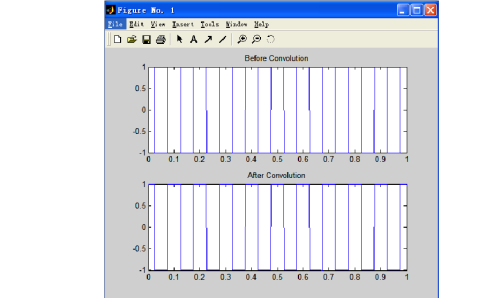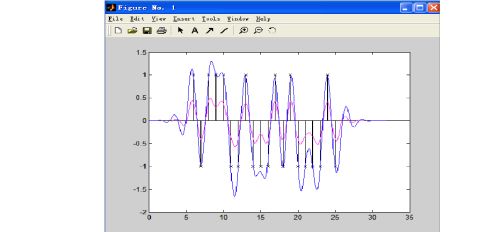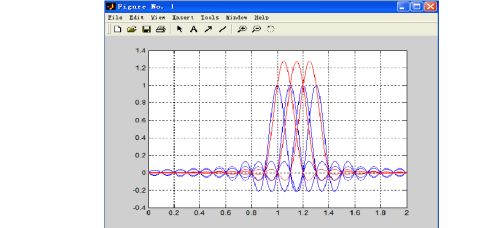脉冲成型实验报告
计算机与信息技术学院综合性实验报告
一、 实验目的
1.了解脉冲信号的成型
2.验证奈奎斯特准则、升余弦滤波器以及部分响应
二、 实验设备
装有matlab仿真软件的PC机一台
三、 实验原理
1.奈奎斯特准则∶ iH ω+2iπ∕Ts =Ts 2.平方根升余弦滤波器的表达式:? ? =
sin π 1?α +4αcos π1+α
π1? 4α
tttT
tT
tT
3.假设信道是理想带限信道,并且存放在发送、接收滤波器,使得:h nT =1 ?=0,1 ,那么满足该条件的滤波器在时域可以认为是两个sinc波形组合而成的 0 n≠0,1
4.In与In?1之间的依赖关系 四、 实验步骤(matlab代码)
第一步,由奈奎斯特准则,假设方波通过一个理想滤波器,来观察各个抽样点的抽样值与输入值的相同情况
%Sampling Frequency & Time Duration fs=1000; t=0:1/fs:1;
%Generate rectangular waveform d=0:0.1:1;
x=2*pulstran(t,d,'rectpuls',0.05)-1; %Generate ideal filter tx=-1:1/fs:1; y=sinc(fs*tx); %Convolution r=conv(x,y);
%Judge the input &output equivalency isequal(int8(x),int8(r(1001:2001))); %drawing subplot(2,1,1); plot(t,x);
title('Before Convolution'); subplot(2,1,2);
plot(t,r(1001:2001)); title('After Convolution');
1
axis tight
第二步,matlab仿真升余弦滤波器,降滚系数为0.22
%Parameters
Delay =3;Fs=8;Fd = 1;
%Generate random data
a=randsrc(20,1,[],1245);
%Consdtruct root-raissd cosine filter with roll-off 0.22
[num,den]=rcosine(Fd,Fs,'fir/sqrt',.22,Delay); %Transmitter filter
[x,tx]=rcosflt(a,Fd,Fs,'filter',num);
%compensate the delay
[z,tz]=rcosflt(x,Fd,Fs,'filter/Fs',num);
%compensate the delay
PropD = Delay *Fd;
ta =[PropD:PropD +20-1]./Fd;
tx=tx +Delay .*Fd;
ta=ta +Delay .*Fd;
%Drawing
stem(ta,a,'kx');hold on;
plot(tx,x,'m-',tz,z,'b-');hold off;
axis([0 30 -1.6 1.6]);
xlabel('Time');ylabel('Amplitude');
第三步,
t=0:0.001:2;
x1=sinc(10*(t-1));
x2=sinc(10*(t-1.1));
x3=sinc(10*(t-1.2));
x4=sinc(10*(t-1.3));
plot(t,x1);hold on
plot(t,x1);hold on;
plot(t,x2);
plot(t,x3);
plot(t,x4);
plot(t,x1+x2,'r');
plot(t,x2+x3,'r');
plot(t,x3+x4,'r');hold off;
gird
第四步,In与In?1之间的依赖关系,有例子来说明
t=0:0.001:2;
x1=sinc(10*(t-1));
x2=sinc(10*(t-1.1));
x3=sinc(10*(t-1.2));
x4=sinc(10*(t-1.3));
plot(t,x1);hold on;
2
plot(t,x2);
plot(t,x3);
plot(t,x4);
plot(t,x1+x2,'r');
plot(t,x2+x3,'r');
plot(t,x3+x4,'r');hold off;
grid
%define data length
len=100;
%Generate the data
a=randint(len,1,2);
%Calculate the b
b=zeros(len+1,1);
for n=2:len+1
b(n)=bitxor(b(n-1),a(n-1));
end
%Calculate the B
B=zeros(10,1);
for n=1:len
B(n)=I(n)+I(n+1);
end
%Decode
ar=mod(B/2+1,2);
%Judge the equality
isequal(a,ar)
五、 实验结果
1. 由奈奎斯特准则,运行实验步骤一的代码,得到个抽样点的抽样值与输入值完全一
样。其图如下:
3
2. matlab仿真升余弦滤波器,其图如下,其中洋红色为发送滤波器的输出波形,蓝色
是接收滤波器的输出波形。


4
3. 滤波器在时域上的图形如下,其中红色为叠加后的波形,被称为双二进制信号,图
中有三个双二进制信号,
4. In与In?1之间的依赖关系,


5
第二篇:热成型空白实验报告
上海电机学院 实 验 报 告
学年第 学期
课程名称
院 (系) 专 业 学生姓名 实验时间 指导教师 提交日期


设计工艺与材料实验报告 实验二:塑料板材的热成型工艺 实验名称:塑料板材的热成型工艺


成 绩 批阅人 一、实验目的
(手写)
二、实验设备及仪器三、实验过程
1. 实验原理
2. 实验内容
四、实验数据及结果
①、 实验材料
。。。。。。。。。。。
②、 实验过程记录
1


③、 实验设备
实验设备:
五、实验工艺示意图
六、附图纸
绘制
2
-
金属系列冲击试验报告
金属系列冲击试验报告一试验目的1了解摆锤冲击试验的基本方法2通过系列冲击试验测定低碳钢工业纯铁和T8钢在不同温度下的冲击吸收功拟合…
-
材料冲击实验报告
一实验目的1观察分析低碳钢材料在常温冲击下的破坏情况和断口形貌2测定低碳钢材料的冲击韧度k值3了解冲击试验方法二实验设备液晶全自动…
-
夏比冲击试验报告
夏比冲击试验报告一实验目的1掌握冲击试验机的结构及工作原理2掌握测定试样冲击性能的方法二实验内容测定低碳钢和铸铁两种材料的冲击韧度…
-
材料冲击实验报告
金属材料冲击试验报告年级20xx级姓名吴明谦学号12220xx10074指导老师龚维老师学院材料与建筑工程学院20xx15一实验目…
-
冲击实验报告
冲击实验报告一实验目的1掌握常温下金属冲击试验方法2了解冲击试验机结构工作原理及正确使用方法二实验设备JBW300冲击试验机及20…
-
工程竣工监理工作总结
尊敬的各位领导、各位来宾:让胡路区建材城外立面改造工程1#楼、4#楼、12#楼经参建单位的共同努力,顺利完工。在此,我代表本工程监…
-
投资咨询公司个人年终总结
一年来,本人认真贯彻执行党的各项路线、方针政策、高举邓--理论伟大旗帜,以“三个代表”重要思想为指导,全面贯彻xx大精神,积极工作…
-
高二半期考试班级总结
高二半期考试质量分析这次半期考试的成绩出来了,总体上来说不错,语文的成绩在这次考试中进步不算太大,所以仍需要努力,虽然此次及格率为…
-
监理工程总结(竣工后的监理总结)
受xx公司委托,xx一期由xx监理有限公司承担施工阶段的监理工作。该工程由xx设计所设计,xx建筑工程有限公司施工,目前该单位工程…
-
20xx年度工作总结
一、在营业部产品建设方面,进行了尝试。在年初继续了由去年年底开始的短线练兵到成立了3个产品小组,从运行上来看,鉴于行情的不断走弱,…